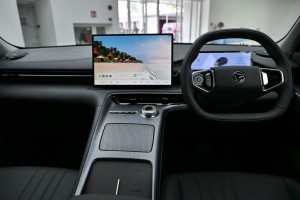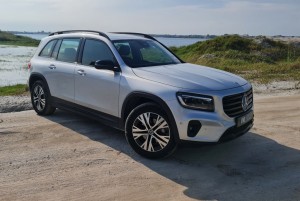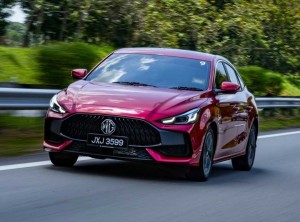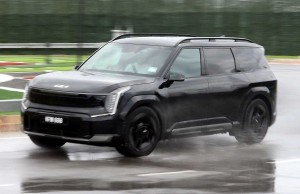LOS ANGELES: It’s high noon on the winding Angeles Crest Highway outside LA, and Dario Franchitti is dancing on the aluminum pedals of a US$3 million (RM13mil) supercar.
He has spent this August morning on the serpentine switchbacks, shifting his way to triple-digit velocity.
He's in a Gordon Murray T.50, a lightweight rocket ship with three seats that’s being produced in a limited run of 100. It’s an insane car, but the most interesting thing isn’t its seating arrangement, nor its eponymous creator, the South African engineer who designed the McLaren F1.
Unveiled in 2021, the T.50 has a gearbox that Franchitti is shifting manually. The car was at the forefront of a revolt against the automatic SUVs, paddle-shift coupes and gearless electric vehicles that dominate roads.
Even as the shifters in sports cars have disappeared, a class of consumers is asking for something their parents took for granted: a manual transmission.

Established automakers and newcomers alike in the past year have rolled out models designed to recapture a visceral connection to driving. Monterey Car Week, an annual automotive orgy in August, was full of them.
Pagani SpA revealed a six-speed transmission in its US$3.4 million (RM14.6mil) Utopia roadster; Tuthill Porsche introduced the GT One, a version of Porsche’s 911 GT1 that offers a six-speed manual setup.
Aston Martin Lagonda’s US$2 million (RM8.6mil) Valour, released in July, likewise pairs a six-speed transmission with its 705-horsepower engine.
"This is a high-wire act,” Franchitti says as he downshifts into a curve, expertly timing the release of the clutch. "I gravitate towards more analogue cars because of the driving experience. I just love it.”
When the first motorised carriages emerged before 1900, operators had to physically sync the speed of the engine to the appropriate gear of the axle turning the wheels.
As the years passed, powerful Bentley Blowers, family sedans and sports coupes all used this manual system of shifting.
In the late 1920s, Maybach was making semiautomatic, smooth and powerful transmissions for its stately Zeppelins; by the end of the next decade, General Motors Co. introduced fully automatic transmissions in the US.
By the 1940s and ’50s, everyone else started using them to make driving easier.
Today, only 2% of new vehicles sold in the US have manual transmissions, per data from CarMax.
Most manufacturers, even famous sports car brands such as Ferrari NV and Automobili Lamborghini SpA, don’t make them at all anymore.
"There are a small group always asking for manual transmissions,” says Stephan Winkelmann, president and chief -executive officer of Lamborghini. "But we are focusing on bigger opportunities.”
A few loyalists can be found across the price spectrum.

Jeep offers one in its Wrangler and Gladiator. Porsche AG makes a six-speed one for some of its 718s and 911s. Mazda Motor Corp. reports a healthy 60% take rate on its manual MX-5.
"I suppose just like gentlemen prefer blondes, gentlemen prefer a manual,” says Ian Scott Dorey, a hair and fashion stylist based in Los Angeles.
He’s on his fourth Mazda Miata stick shift.
"My car is made for ultimate maneuverability in all situations, and the stick is a part of that,” he says. "There’s just something about slamming the pedal and taking off in a burst of speed.”
Subaru makes two models with a manual transmission.
For 2024 through August, 79% of BRZ and 87% of WRX sales have been manuals, a spokesperson says. Todd Templeman, a Portland, Oregon-based photographer, has been shifting his 2013 Subaru WRX STI GR for a decade.
For him, it’s about sensory pleasures-the sound of the engine revving, the feel of clutch under his foot, the wind running through his mullet from the open window as he rows through gears.

"A perfect rev-match downshift before a corner is one of the best feelings in the world,” he says.
But these adherents remain oddities. Enrico Galliera, Ferrari’s chief marketing and commercial officer, says it offered manual gearboxes up until the California: "The take rate was 0.001%.”
Mark Reuss, president of GM, says implementing a stick shift creates costs that stretch across the model line and are too high to justify.
"Adding a manual is just a bridge too far,” he says. The last manual Corvette came out in 2019.
It stands to reason most people would prefer a vehicle to shift for itself.
An automatic is faster and more precise, and anyone who’s met a stoplight on a steep hill or worked through traffic with a heavy clutch and a throbbing left quad knows manual gearboxes can engender anxiety, fatigue and, when done poorly, mechanical headaches and expenses.
"Customers that desire a manual car are driving enthusiasts,” says Alex Long, director of product strategy at Aston Martin.
And that enthusiasm comes with bragging rights. Early manuals were hot and heavy; a misplaced shift could blow the engine or burn through the clutch. Mastering it meant you were worthy of such a glorious machine.
"Driving the original Diablo was really a job for strong men,” says Maurizio Reggiani, former chief technical officer at Lamborghini and now chief adviser of Eccentrica, the company restoring Diablos for €1.35 million (RM6.5mil) apiece.
They’ll include an easier-to-use version of the original’s six-speed manual, which required more than 40kg of load just to push the clutch.
"If you weigh 50 kilos, you need to put all your weight to push down,” Reggiani says. "This creates a beast to drive.”
The stick-shift cars coming to market alleviate much of that struggle, with lighter clutches and modern conveniences like rev matching and hill assist, which holds the car in place on inclines.

They also appeal because they’re likely to retain or even gain value.
Models that were the last from a brand to carry a stick shift, for example, have jumped in cost.
In the past three years, the price of a top-condition manual 2004 Lamborghini Gallardo has risen over 35%, to US$182,000, and average values are 50% higher than the automatic, according to Hagerty.
Prices have risen 21% for a manual 2002 Lamborghini Murciélago.
The cost of a manual 1985 Ferrari 412i in top condition is up 50%, to US$52,000 (RM224,000), and one will generally run you 50% more than an automatic.
Among cars on auction website Bring a Trailer, which trade at more modest price points, the price difference for manual versus automatic cars can be extreme: Of the 24 most recently sold BMW E46 M3 coupes (a sports car from the early 2000s), the average for an automatic was US$28,901 (RM125,000). The manuals averaged US$43,469 (RM187,000).
"We’re seeing manual variants become significantly more desirable,” says Ethan Gibson, a spokesman for RM Sotheby’s. "They’re analogue, engaging, mechanical and rarer, and in the collector market, rarity instantly adds value.”

At a downtown LA warehouse, new automaker Sasha Selipanov was delivering his own manual manifesto to a roomful of supporters. He’s angry, he says. People have forgotten that cars are about "emotional fulfillment.”
The former Genesis designer says, "The old-school stuff is always what did it for me; I felt a connection that is not happening with modern stuff.”
He founded Nilu27 LLC in 2023, and his seven-speed manual V-12 called the Nilu27 will fix that problem, he says.
"We must eliminate every interface between the driver and the road. We need to shift gears!”
The crowd whoops and cheers.
"People get it,” says Franchitti earlier in the day, sliding into fifth gear in a well-timed shift that lowered the whir of the engine and blasted the car up Highway 2. "The T.50 sold out in two days. Obviously I am not alone.”













